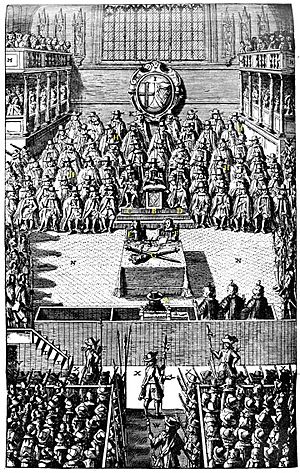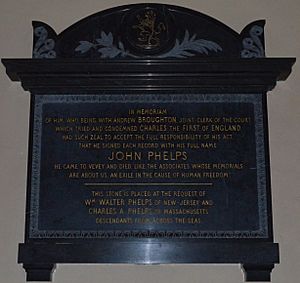John Phelps (regicide) facts for kids
Quick facts for kids
John Phelps
|
|
|---|---|
| Born | circa 1619 |
| Died | aft 1666 |
| Resting place | St Martin's Cathedral, Vevey, Switzerland |
| Nationality | English |
| Occupation | Clerk and government servant |
| Known for | Clerk of the High Court at the trial of Charles I |
John Phelps was an important government worker in England during the 1600s. He served as a clerk for a special court called the High Court. This court was set up to try King Charles I of England for a serious crime called high treason in 1649. Phelps played a key role in recording what happened during this famous trial.
Contents
John Phelps' Early Life
Not much is known about John Phelps' early years. He was born around 1619 in Salisbury, a town in Wiltshire, England. When he was about 17, in 1636, he started studying at Corpus Christi College at the University of Oxford. His father was Robert Phelps, also from Salisbury.
Later, in 1649, John Phelps became an assistant clerk for the House of Commons. This was an important step in his career as a government servant.
Why People Opposed King Charles I
John Phelps and his family were part of a group who disagreed with King Charles I and his style of rule. They felt the King and the church were becoming too powerful and unfair. They also thought the King was asking for too much money in taxes.
Many English people shared these feelings. This disagreement eventually led to the English Revolution, also known as the English Civil War, which started in 1642. People believed King Charles I was secretly trying to get foreign armies to invade England. They thought he wanted to crush the Parliament and take away the rights of the English people.
Because of these actions, many felt that King Charles I was putting his own interests above those of Parliament and the country. This led to his trial and execution for treason in 1649.
Phelps' Role in the King's Trial
In 1648-1649, a part of Parliament called the Rump Parliament chose John Phelps for a very important job. He was to be the Clerk of the High Court during the trial of King Charles I.
Phelps became a close assistant to Oliver Cromwell, a powerful leader at the time. In the picture of the trial, you can see John Phelps sitting at the right side of the table in the middle of the room. Records from the trial show that John Phelps and Andrew Broughton were officially chosen as clerks for the court. They were ordered to attend all the court sessions.
During the trial, King Charles I refused to accept the court's authority. John Phelps, as the Clerk, formally asked the King for his answer. When the King refused to respond, it was recorded as a "default." Under English law at that time, refusing to enter a plea was seen as admitting guilt.
At the end of the trial, John Phelps signed the official records. This showed his direct involvement and responsibility for the court's decisions.
Phelps' Work After the Trial
John Phelps was a well-respected person among his political group. He continued to work as a clerk and registrar for various government committees. He had offices in the Old Palace, where these committees met.
In 1652, he was appointed as a clerk for a special committee of Parliament. This committee was meeting with representatives from Scotland. Phelps was given instructions to make sure the meeting room was comfortable and warm. He also helped organize important papers and books related to Scotland.
Later, in 1653, John Phelps was asked to check his records for information about a Scottish Earl's estate. He was also one of three people chosen to sort through Scottish historical documents kept in the Tower of London. They had to report their findings to the council.
Hampton Court Palace Purchase
John Phelps once bought a large estate called Hampton Court. This grand property, located by the River Thames, had belonged to the Crown. However, Oliver Cromwell, who was then the Lord Protector of England, wanted Hampton Court for himself.
So, a committee was formed to negotiate with Phelps. They agreed to buy the property back from him for £750. This shows that Phelps was a smart businessman, as this price was considered fair. The deal was completed in August 1654, and Phelps received the money.
Phelps was also very good at shorthand, a fast way of writing. This skill helped him record important information, like the evidence given during trials. Just before his political party lost power, in 1659, Parliament gave John Phelps £50 for his services as a clerk.
These events show that John Phelps was very helpful to his political party. He was willing and able to work in important roles. He was not overly rewarded, which suggests he was a dedicated public servant.
Life After the King's Return
In 1660, King Charles II returned to the throne. This event is known as the Restoration. A new law was passed called the Indemnity and Oblivion Act. This law offered a pardon to most people who had supported the previous government. However, it did not pardon those who had directly taken part in the trial and execution of King Charles I.
John Phelps was one of the people who were sought for prosecution. If arrested, his punishment would have been severe. He would have been dragged through the streets and then imprisoned for life.
The law stated that John Phelps and others would lose all their titles and honors. They would no longer be called "Gentleman" or "Esquire" and would be seen as "Persons of Dishonour and Infamy."
Living in Exile
Luckily, John Phelps managed to escape. He went to Lausanne, Switzerland, where he lived with Edmund Ludlow, one of the judges who had condemned Charles I, and his fellow clerk Andrew Broughton. Phelps and Broughton were fortunate to live out their lives safely in Vevey, Switzerland.
During the English Restoration, any property John Phelps still owned in England was taken away. He died after 1666 and was buried in St Martin's Cathedral in Vevey. He rests there alongside Edmund Ludlow and Andrew Broughton.
St Martin's Church Memorial
In 1881, James A. Garfield, who was the President of the United States, appointed William Walter Phelps as a diplomat to Austria-Hungary. While serving there, William W. Phelps traveled to Vevey, Switzerland. There, he and Charles A. Phelps, M.D., from Massachusetts, arranged for a memorial to be placed for their ancestor, John Phelps.
The top of the monument shows the Phelps coat of arms, which features a lion with a collar and chain.
The words on the monument honor John Phelps. It says that he was a clerk for the court that tried King Charles I. It mentions his strong desire to take full responsibility for his actions by signing every record with his full name. The monument also states that he came to Vevey and died there as an exile, fighting for human freedom. This memorial was placed by his descendants from across the seas.



